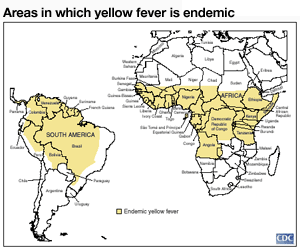Yellow Fever

Yellow Fever Facts:
Though Yellow Fever is currently only found in Africa and South America, it still greatly impacts those areas and is an issue of consideration for anyone traveling to regions that have a history of Yellow Fever. Fever is a flavivirus and is transmitted by the Yellow Fever mosquito, Aedes aegypti. For over 60 years there has been an effective vaccine available, but even so, the cases of Yellow Fever have been increasing.
Infection with the Yellow Fever virus will not have any symptoms for three to six days. Some people infected will continue to show no, or minimal symptoms to the infection. Most cases however will experience the “acute phase” of the disease, which is characterized by fever, muscle pain, headache, shivers, loss of appetite, nausea and/or vomiting. This phase typically last three to four days and most cases will then make recovery.
Fifteen percent of infections will continue from the 'acute phase' into the 'toxic phase'. This occurs within 24 hours as the disease is affecting the body quickly and severely. Rapid development of jaundice (yellowing of the skin and whites of the eyes) occurs along with fever, abdominal pain and vomiting. Bleeding from the mouth, nose, eyes and/or stomach can accompany this phase and will lead to blood appearing in the vomit and feces. This characteristic of Yellow Fever is attributed with one of its common names, Black Vomit. Deterioration of kidney function follows, though this can be minor to complete kidney failure. 50% of the patients that enter the 'toxic phase' will die within 10-14 days. For those whom survive, it is without significant organ damage.
Yellow Fever is hard to identify and diagnose, so underreporting undoubtedly occurs. It is estimated that there are about 200,000 cases, with 30,000 deaths occurring, annually from Yellow Fever.
Though there is not any specific treatment of this disease there is a safe and effective vaccine. The vaccine provides immunity in about one week for 95% of people vaccinated and is effective for 10 years (and possibly provides lifelong protection).
Continuing Risk:
In some areas of Africa and South America the virus is constantly present at an endemic stage (low level of infection) and the virus can regularly amplify into epidemic levels. Since the 1900s, outbreaks of Yellow Fever have not occurred in Europe, the Caribbean Islands, or Central and North America. But history has shown that these regions have seen outbreaks before and experience indicates that the potential for future outbreaks still do exist.
